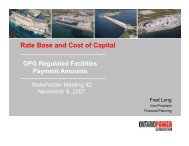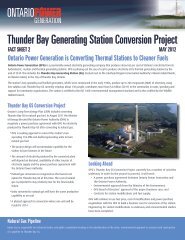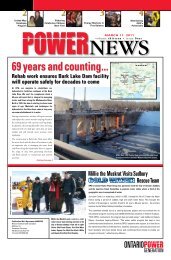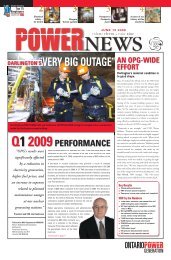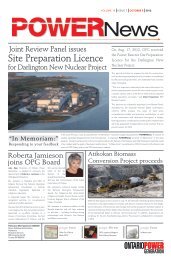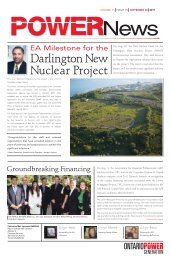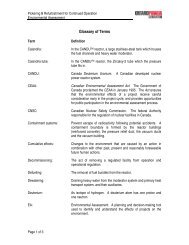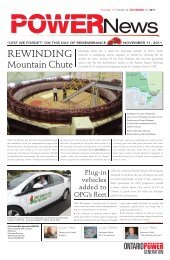Draft Scoping Information Document - Ontario Power Generation
Draft Scoping Information Document - Ontario Power Generation
Draft Scoping Information Document - Ontario Power Generation
You also want an ePaper? Increase the reach of your titles
YUMPU automatically turns print PDFs into web optimized ePapers that Google loves.
July 2011<br />
<strong>Draft</strong> <strong>Scoping</strong> <strong>Information</strong> <strong>Document</strong> - Proposal by OPG - Refurbishment and<br />
Continued Operation - Darlington Nuclear Generating Station, Clarington, <strong>Ontario</strong><br />
recovery strategy and action plans. Therefore, the proponent must include<br />
information in the EIS that will allow the Responsible Authorities to meet this<br />
requirement.<br />
Mitigation strategies should reflect avoidance, precautionary and preventive<br />
principles; that is, emphasis should be placed on tempering or preventing the<br />
cause or source of an effect, or sequence of effects, before addressing how to<br />
attenuate, reverse or compensate for an effect once it occurs. The proponent shall<br />
consider the guiding principles set out in the Framework for the Application of<br />
Precaution in Science-based Decision Making About Risk [Reference 12].<br />
Where the prevention of effects cannot be assured, or the effectiveness of<br />
preventive mitigation measures is uncertain, further mitigation measures in the<br />
form of contingency responses, including emergency response plans, will be<br />
described and considered through the follow-up program (Section 7.0).<br />
Those effects to the environment that would remain after the implementation of<br />
mitigation measures should be identified as residual effects. Any residual effects<br />
identified should be assessed as to their significance.<br />
The EIS must identify the criteria used to assign significance ratings to any<br />
predicted adverse effects. The EIS must contain a detailed analysis of the<br />
significance of the potential residual adverse environmental effects it predicts. It<br />
must contain clear and sufficient information to enable the CNSC and the public<br />
to understand and review the proponent's judgment of the significance of effects.<br />
The proponent must define the terms used to describe the level of significance.<br />
4.5 Assessment of Effects of the Environment on the Project<br />
The assessment must also take into account how the environment could adversely<br />
affect the project; for example, from severe weather, geotechnical hazards or<br />
seismic events. The assessment must also take into account any potential effects<br />
of climate change on the project, including an assessment of whether the project<br />
might be sensitive to changes in climate conditions during its life span. Guidance<br />
can be found on the Canadian Environment Assessment Agency website<br />
[Reference 13]. An identification and discussion of any lessons learned from the<br />
events at Fukushima to the extent that they are relevant to the assessment of<br />
effects of the environment on the project should be included.<br />
This part of the assessment will be conducted in a step-wise fashion, similar to<br />
that described for the foregoing assessment of the project effects. The possible<br />
important interactions between the natural hazards and the project will be first<br />
identified, followed by an assessment of the effects of those interactions, the<br />
available additional mitigation measures, and the significance of any remaining<br />
residual adverse environmental effects.<br />
e-DOC 3734740 - 20 -<br />
CEAR 11-01-62516



